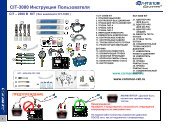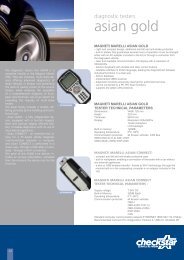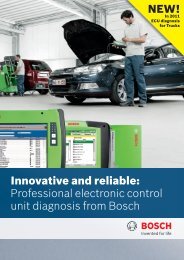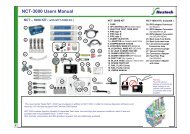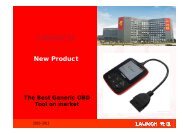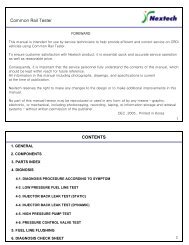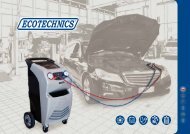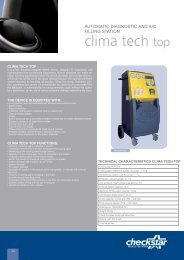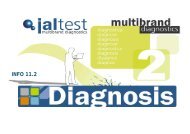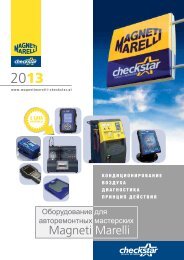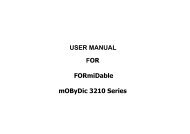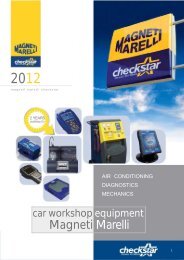Download It - diagtools ltd
Download It - diagtools ltd
Download It - diagtools ltd
Create successful ePaper yourself
Turn your PDF publications into a flip-book with our unique Google optimized e-Paper software.
LAUNCH<br />
CReaderVI User’s Manual, (c)Launch, www.x431.lv<br />
2011-03-01<br />
V1.00.001<br />
Diagtools LTD, www.x431.lv
LAUNCH<br />
CReaderVI User’s Manual, (c)Launch, www.x431.lv<br />
Trademark Information<br />
LAUNCH is a registered trademark of LAUNCH TECH CO., LTD. (LAUNCH) in China and<br />
other countries. All other LAUNCH trademarks, service marks, domain names, logos and<br />
company names referred to in this manual are either trademarks, registered trademarks,<br />
service marks, domain names, logos and company names of or are otherwise the property of<br />
LAUNCH or its affiliates. In countries where any of the LAUNCH trademarks, service marks,<br />
domain names, logos and company names are not registered, LAUNCH claims other rights<br />
associated with unregistered trademarks, service marks, domain names, logos and company<br />
names. Other products or company names referred to in this manual may be trademarks of<br />
their respective owners. You may not use any trademark, service mark, domain name, logo,<br />
or company name of LAUNCH or any third party without permission from the owner of the<br />
applicable trademark, service mark, domain name, logo, or company name. You may contact<br />
LAUNCH at www.cnlaunch.com, or write to LAUNCH TECH. CO., LTD.,Launch Industrial<br />
Park, North of Wuhe Avenue, Banxuegang, Bantian, Longgang, Shenzhen, Guangdong,P.R.<br />
China, to request written permission to use Materials on this manual for purposes or for all<br />
other questions relating to this manual.<br />
Copyright Information<br />
Copyright © 2010 by LAUNCH TECH. CO., LTD. All rights reserved. No part of this<br />
publication may be reproduced, stored in a retrieval system, or transmitted in any form or by<br />
any means, electronic, mechanical, photocopying and recording or otherwise, without the<br />
prior written permission of LAUNCH. The information contained herein is designed only for<br />
the use of this unit. LAUNCH is not responsible for any use of this information as applied to<br />
other units.<br />
i<br />
Diagtools LTD, www.x431.lv
LAUNCH<br />
CReaderVI User’s Manual, (c)Launch, www.x431.lv<br />
End User License Agreement<br />
IMPORTANT: PLEASE READ THIS END USER LICENSE AGREEMENT CAREFULLY.<br />
USING LAUNCH OR LAUNCH-SUPPLIED PRODUCTS AND SOFTWARE CONSTITUTES<br />
ACCEPTANCE OF THIS AGREEMENT.<br />
LAUNCH IS WILLING TO LICENSE THE PRODUCTS, INFORMATION, SOFTWARE AND<br />
DOCUMENTS (COLLECTIVELY, “MATERIALS”) TO YOU ONLY UPON THE CONDITION<br />
THAT YOU ACCEPT ALL OF THE TERMS CONTAINED IN THIS LICENSE AGREEMENT.<br />
BY USING THE MATERIALS, YOU ARE BINDING YOURSELF AND THE BUSINESS<br />
ENTITY THAT YOU REPRESENT (COLLECTIVELY, “CUSTOMER”) TO THIS AGREEMENT.<br />
IF YOU DO NOT AGREE TO ALL OF THE TERMS OF THIS AGREEMENT, THEN LAUNCH<br />
IS UNWILLING TO LICENSE THE MATERIALS TO YOU AND DO NOT USE THE<br />
PRODUCTS AND DOWNLOAD OR INSTALL THE SOFTWARE.<br />
The following terms of this End User License Agreement (“Agreement”) govern Customer’s<br />
access and use of the product, except to the extent there is a separate signed agreement<br />
between Customers and LAUNCH governing Customer’s use.<br />
License. Conditioned upon compliance with the terms and conditions of this Agreement,<br />
LAUNCH TECH. CO., LTD., or its subsidiary licensing the Materials instead of LAUNCH,<br />
grants to Customer a nonexclusive and nontransferable license to use for Customer’s internal<br />
business purposes the Materials and the Document for which Customer has paid the required<br />
license fees. “Document” means written information (whether contained in user or technical<br />
manuals, training materials, specifications or otherwise) specifically pertaining to the<br />
equipment and made available by LAUNCH with the equipment in any manner (including on<br />
CD-Rom, or on-line).<br />
Unless otherwise expressly provided in the Document, Customer shall use the Software<br />
solely as embedded in, for execution on or (where the applicable document permits<br />
installation on non-LAUNCH equipment) for communication with LAUNCH equipment owned<br />
or leased by Customer and used for Customer’s internal business purposes.<br />
Note: For evaluation or beta copies for which LAUNCH does not charge a license fee, the<br />
above requirement to pay license fees does not apply.<br />
General Limitations. This is a license, not a transfer of title, to the materials, and LAUNCH<br />
retains ownership of all copies of the Materials. Customer acknowledges that the Materials<br />
contain trade secrets of LAUNCH, its suppliers or licensors, including but not limited to the<br />
specific internal designed structure of individual programs and associated interface<br />
information. Accordingly, except as otherwise expressly provided under this Agreement,<br />
Customer shall have no right and Customer specifically agrees not to:<br />
(i) Transfer, assign or sublicense its license rights to any other person or entity, or use the<br />
Materials on unauthorized or secondhand LAUNCH equipment, and Customer acknowledges<br />
that any attempted transfer, assignment, sublicense or use shall be void;<br />
(ii) Make error corrections to or otherwise modify or adapt the Materials or create derivative<br />
works based upon the Materials, or permit third parties to do the same;<br />
(iii) Reverse engineer or decompile, decrypt, disassemble or otherwise reduce the Materials<br />
ii<br />
Diagtools LTD, www.x431.lv
LAUNCH<br />
CReaderVI User’s Manual, (c)Launch, www.x431.lv<br />
to human-readable form, except to the extent otherwise expressly permitted under applicable<br />
law notwithstanding this restriction;<br />
(iv) Use or permit the Materials to be used to perform services for third parties, whether on a<br />
service bureau or time sharing basis or otherwise, without the express written authorization of<br />
LAUNCH;<br />
(v) Disclose, provide, or otherwise make available trade secrets contained within the<br />
Materials in any form to any third party without the prior written consent of LAUNCH.<br />
Customer shall implement reasonable security measures to protect such trade secrets.<br />
To the extent required by law, and at Customer’s written request, LAUNCH shall provide<br />
Customer with the interface information needed to achieve interoperability between the<br />
Materials and another independently created program, on payment of LAUNCH’s applicable<br />
fee, if any. Customer shall observe strict obligations of confidentiality with respect to such<br />
information and shall use such information in compliance with any applicable terms and<br />
conditions upon which LAUNCH makes such information available.<br />
Software, Upgrades and Additional Copies. For purposes of this Agreement, “Software” shall<br />
include (and the terms and conditions of this Agreement shall apply to) computer programs,<br />
including firmware, as provided to Customer by LAUNCH or an authorized LAUNCH reseller,<br />
and any upgrades, updates, bug fixes or modified versions thereto (collectively, “Upgrades”)<br />
or backup copies of the Software licensed or provided to Customer by LAUNCH or an<br />
authorized LAUNCH reseller.<br />
NOTWITHSTANDING ANY OTHER PROVISION OF THIS AGREEMENT: (1) CUSTOMER<br />
HAS NO LICENSE OR RIGHT TO USE ANY ADDITIONAL COPIES OR UPGRADES<br />
UNLESS CUSTOMER, AT THE TIME OF ACQUIRING SUCH COPY OR UPGRADE,<br />
ALREADY HOLDS A VALID LICENSE TO THE ORIGINAL SOFTWARE AND HAS PAID THE<br />
APPLICABLE FEE FOR THE UPGRADE OR ADDITIONAL COPIES; (2) USE OF<br />
UPGRADES IS LIMITED TO LAUNCH EQUIPMENT FOR WHICH CUSTOMER IS THE<br />
ORIGINAL END USER PURCHASER OR LESSEE OR WHO OTHERWISE HOLDS A VALID<br />
LICENSE TO USE THE SOFTWARE WHICH IS BEING UPGRADED; AND (3) THE MAKING<br />
AND USE OF ADDITIONAL COPIES IS LIMITED TO NECESSARY BACKUP PURPOSES<br />
ONLY.<br />
Proprietary Notices. Customer agrees to maintain and reproduce all copyright and other<br />
proprietary notices on all copies, in any form, of the Materials in the same form and manner<br />
that such copyright and other proprietary notices are included on the Materials. Except as<br />
expressly authorized in this Agreement, Customer shall not make any copies or duplicates of<br />
any Materials without the prior written permission of LAUNCH.<br />
Term and Termination. This Agreement and the license granted herein shall remain effective<br />
until terminated. Customer may terminate this Agreement and the license at any time by<br />
destroying all copies of Materials and any Document. Customer’s rights under this Agreement<br />
will terminate immediately without notice from LAUNCH if Customer fails to comply with any<br />
provision of this Agreement. Upon termination, Customer shall destroy all copies of Software<br />
in its possession or control. All confidentiality obligations of Customer and all limitations of<br />
liability and disclaimers and restrictions of warranty shall survive termination of this<br />
Agreement.<br />
iii<br />
Diagtools LTD, www.x431.lv
LAUNCH<br />
CReaderVI User’s Manual, (c)Launch, www.x431.lv<br />
Customer Records. Customer grants to LAUNCH and its independent accountants the right to<br />
examine Customer’s books, records and accounts during Customer's normal business<br />
hours to verify compliance with this Agreement. In the event such audit discloses<br />
non-compliance with this Agreement, Customer shall promptly pay to LAUNCH the<br />
appropriate license fees, plus the reasonable cost of conducting the audit.<br />
Export. Software, including technical data, may be subject to PRC. export control laws,<br />
including the PRC. Export Administration Act and its associated regulations, and may be<br />
subject to export or import.<br />
General Notice<br />
• Other product names used herein are for identification purposes only and may be<br />
trademarks of their respective owners. LAUNCH disclaims any and all rights in those<br />
marks.<br />
• There is a possibility that this unit is inapplicable to some of the vehicle models or<br />
systems listed in the diagnosis section due to different countries, areas, and/or years.<br />
Do not hesitate to contact LAUNCH if you come across such questions. We are to<br />
help you solve the problem as soon as possible.<br />
Disclaimer<br />
• To take full advantage of the unit, you should be familiar with the engine.<br />
• All information, illustrations, and specifications contained in this manual are based on<br />
the latest information available at the time of publication. The right is reserved to<br />
make change at any time without notice.<br />
• Neither LAUNCH nor its affiliates shall be liable to the purchaser of this unit or third<br />
parties for damages, losses, costs or expenses incurred by purchaser or third parties<br />
as a result of: accident, misuse, or abuse of this unit, or unauthorized modifications,<br />
repairs, or alterations to this unit, or failure to strictly comply with LAUNCH operating<br />
and maintenance instructions.<br />
• LAUNCH shall not be liable for any damages or problems arising from the use of any<br />
options or any consumable products other than those designated as Original<br />
LAUNCH Products or LAUNCH Approved Products by LAUNCH.<br />
•<br />
Safety Precautions and Warnings<br />
To prevent personal injury or damage to vehicles and/or the CReaderVI,<br />
please read this user’s manual first carefully and observe the following<br />
safety precautions at a minimum whenever working on a vehicle:<br />
• Always perform automotive testing in a safe environment.<br />
• Do not attempt to operate or observe the tool while driving a vehicle.<br />
iv<br />
Diagtools LTD, www.x431.lv
LAUNCH<br />
CReaderVI User’s Manual, (c)Launch, www.x431.lv<br />
Operating or observing the tool will cause driver distraction and could<br />
cause a fatal accident.<br />
• Wear safety eye protection that meets ANSI standards.<br />
• Keep clothing, hair, hands, tools, test equipment, etc. away from all<br />
moving or hot engine parts.<br />
• Operate the vehicle in a well-ventilated work area: Exhaust gases are<br />
poisonous.<br />
• Put blocks in front of the drive wheels and never leave the vehicle<br />
unattended while running tests.<br />
• Use extreme caution when working around the ignition coil, distributor<br />
cap, ignition wires and spark plugs. These components create<br />
hazardous voltages when the engine is running.<br />
• Put the transmission in P (for A/T) or N (for M/T) and make sure the<br />
parking brake is engaged.<br />
• Keep a fire extinguisher suitable for gasoline/chemical/ electrical fires<br />
nearby.<br />
• Don’t connect or disconnect any test equipment while the ignition is on<br />
or the engine is running.<br />
• Keep the CReaderVI dry, clean, free from oil/water or grease. Use a<br />
mild detergent on a clean cloth to clean the outside of the CReaderVI,<br />
when necessary.<br />
v<br />
Diagtools LTD, www.x431.lv
LAUNCH<br />
CReaderVI User’s Manual, (c)Launch, www.x431.lv<br />
Table of Contents<br />
1. INTRODUCTION .......................................................... 3<br />
2. GENERAL INFORMATION-ABOUT OBDII/EOBD ........ 3<br />
2.1 ON-BOARD DIAGNOSTICS (OBD) II.............................. 3<br />
2.2 DIAGNOSTIC TROUBLE CODES (DTCS) ......................... 4<br />
2.3 LOCATION OF THE DATA LINK CONNECTOR (DLC) .......... 5<br />
2.4 OBD II READINESS MONITORS .................................... 5<br />
2.5 OBD II MONITOR READINESS STATUS .......................... 6<br />
2.6 OBD II DEFINITIONS .................................................. 7<br />
3. PRODUCT DESCRIPTIONS ......................................... 9<br />
3.1 OUTLINE OF CREADERVI ............................................ 9<br />
3.2 SPECIFICATIONS ...................................................... 10<br />
3.3 ACCESSORIES INCLUDED .......................................... 10<br />
3.4 POWER SUPPLY ....................................................... 10<br />
3.5 TOOL SETUP ........................................................... 10<br />
3.6 VEHICLE COVERAGE ................................................ 13<br />
4. OPERATION .............................................................. 13<br />
4.1 CONNECTION .......................................................... 13<br />
4.2 DIAGNOSTIC ........................................................... 14<br />
4.2.1 Read Codes .................................................. 14<br />
4.2.2 Erase Codes .................................................. 16<br />
4.2.3 I/M Readiness ................................................ 17<br />
4.2.4 Data Stream .................................................. 18<br />
4.2.5 View Freeze Frame ........................................ 22<br />
4.2.6 O2 sensor test ............................................... 23<br />
4.2.7 On-board monitor test .................................... 25<br />
4.2.8 EVAP System Test ......................................... 26<br />
4.2.9 Vehicle Info .................................................... 27<br />
4.3 CODE LOOKUP ........................................................ 27<br />
4.4 REVIEW ................................................................. 28<br />
4.5 HELP ..................................................................... 30<br />
1<br />
Diagtools LTD, www.x431.lv
LAUNCH<br />
CReaderVI User’s Manual, (c)Launch, www.x431.lv<br />
5. UPGRADING ............................................................. 32<br />
5.1 CREADERVI UPGRADING FLOW.................................. 32<br />
5.2 USER REGISTRATION ................................................ 33<br />
5.3 UPGRADING ............................................................ 33<br />
6 FAQ ............................................................................ 34<br />
2<br />
Diagtools LTD, www.x431.lv
LAUNCH<br />
CReaderVI User’s Manual, (c)Launch, www.x431.lv<br />
1. INTRODUCTION<br />
The CReader VI is a game changer in the world of portable Automotive<br />
Diagnostics. Is it a code scanner, or is it a scan tool? The CReader VI blurs<br />
the lines by being the first full color, 4 PID graphing code scanner in the<br />
market. The CReader VI boasts an industry leading 2 frames per second data<br />
capture, while having the ability to store, record and playback over 29 data<br />
files, lasting over 8 hours! The CReader VI is also very easy to use. With<br />
built-in help menus and code definitions, diagnosing and repairing that<br />
dreaded Check Engine Light is now easier than ever! And we don’t stop there.<br />
The CReader VI also features the following bi-directional “special tests”:<br />
EVAP, 02 Sensor, I/M Readiness, MIL Status, VIN Info, and On-board<br />
monitors testing.<br />
NOTICE: CREADERVI MAY AUTOMATICALLY RESET WHILE<br />
BEING DISTURBED BY STRONG STATIC ELECTRICITY.<br />
THIS IS A NORMAL REACTION.<br />
2. General Information-About OBDII/EOBD<br />
2.1 On-Board Diagnostics (OBD) II<br />
The first generation of On-Board Diagnostics (called OBD I) was developed<br />
by the California Air Resources Board (ARB) and implemented in 1988 to<br />
monitor some of the emission control components on vehicles. As technology<br />
evolved and the desire to improve the On-Board Diagnostic system increased,<br />
a new generation of On-Board Diagnostic system was developed. This<br />
second generation of On-Board Diagnostic regulations is called "OBD II".<br />
The OBD II system is designed to monitor emission control systems and key<br />
engine components by performing either continuous or periodic tests of<br />
specific components and vehicle conditions. When a problem is detected, the<br />
OBD II system turns on a warning lamp (MIL) on the vehicle instrument panel<br />
to alert the driver typically by the phrase of “Check Engine” or “Service<br />
Engine Soon”. The system will also store important information about the<br />
detected malfunction so that a technician can accurately find and fix the<br />
problem. Here below follow three pieces of such valuable information:<br />
1) Whether the Malfunction Indicator Light (MIL) is commanded<br />
'on' or 'off';<br />
2) Which, if any, Diagnostic Trouble Codes (DTCs) are stored;<br />
3<br />
Diagtools LTD, www.x431.lv
LAUNCH<br />
CReaderVI User’s Manual, (c)Launch, www.x431.lv<br />
3) Readiness Monitor status.<br />
2.2 Diagnostic Trouble Codes (DTCs)<br />
OBD II Diagnostic Trouble Codes are codes that are stored by the on-board<br />
computer diagnostic system in response to a problem found in the vehicle.<br />
These codes identify a particular problem area and are intended to provide<br />
you with a guide as to where a fault might be occurring within a vehicle. OBD<br />
II Diagnostic Trouble Codes consist of a five-digit alphanumeric code. The<br />
first character, a letter, identifies which control system sets the code. The<br />
second character, a number, 0-3; other three characters, a hex character, 0-9<br />
or A-F provide additional information on where the DTC originated and the<br />
operating conditions that caused it to set. Here below is an example to<br />
illustrate the structure of the digits:<br />
4<br />
Diagtools LTD, www.x431.lv
LAUNCH<br />
CReaderVI User’s Manual, (c)Launch, www.x431.lv<br />
2.3 Location of the Data Link Connector (DLC)<br />
The DLC (Data Link Connector or Diagnostic Link Connector) is the<br />
standardized 16-cavity connector where diagnostic code readers interface<br />
with the vehicle's on-board computer. The DLC is usually located 12 inches<br />
from the center of the instrument panel (dash), under or around the driver’s<br />
side for most vehicles. If Data Link Connector is not located under dashboard,<br />
a label should be there telling location. For some Asian and European<br />
vehicles, the DLC is located behind the ashtray and the ashtray must be<br />
removed to access the connector. If the DLC cannot be found, refer to the<br />
vehicle’s service manual for the location.<br />
2.4 OBD II Readiness Monitors<br />
An important part of a vehicle’s OBD II system is the Readiness Monitors,<br />
which are indicators used to find out if all of the emissions components have<br />
been evaluated by the OBD II system. They are running periodic tests on<br />
specific systems and components to ensure that they are performing within<br />
allowable limits.<br />
Currently, there are eleven OBD II Readiness Monitors (or I/M Monitors)<br />
5<br />
Diagtools LTD, www.x431.lv
LAUNCH<br />
CReaderVI User’s Manual, (c)Launch, www.x431.lv<br />
defined by the U.S. Environmental Protection Agency (EPA). Not all monitors<br />
are supported in every vehicles and the exact number of monitors in any<br />
vehicle depends on the motor vehicle manufacturer’s emissions control<br />
strategy.<br />
Continuous Monitors -- Some of the vehicle components or systems are<br />
continuously tested by the vehicle’s OBD II system, while others are tested<br />
only under specific vehicle operating conditions. The continuously monitored<br />
components listed below are always ready:<br />
1)Misfire<br />
2)Fuel System<br />
3)Comprehensive Components (CCM)<br />
Once the vehicle is running, the OBD II system is continuously checking the<br />
above components, monitoring key engine sensors, watching for engine<br />
misfire, and monitoring fuel demands.<br />
Non-Continuous Monitors -- Unlike the continuous monitors, many<br />
emissions and engine system components require the vehicle to be operated<br />
under specific conditions before the monitor is ready. These monitors are<br />
termed non-continuous monitors and are listed below:<br />
1) EGR System<br />
2) O2 Sensors<br />
3) Catalyst<br />
4) Evaporative System<br />
5) O2 Sensor Heater<br />
6) Secondary air Injection<br />
7) Heated Catalyst<br />
8) A/C system<br />
2.5 OBD II Monitor Readiness Status<br />
OBD II systems must indicate whether or not the vehicle’s PCM’s monitor<br />
system has completed testing on each component. Components that have<br />
been tested will be reported as “Ready”, or “Complete”, meaning they have<br />
been tested by the OBD II system. The purpose of recording readiness status<br />
is to allow inspectors to determine if the vehicle’s OBD II system has tested<br />
all the components and/or systems.<br />
The powertrain control module (PCM) sets a monitor to “Ready” or<br />
“Complete” after an appropriate drive cycle has been performed. The drive<br />
cycle that enables a monitor and sets readiness codes to “Ready” varies for<br />
each individual monitor. Once a monitor is set as “Ready” or “Complete”, it<br />
6<br />
Diagtools LTD, www.x431.lv
LAUNCH<br />
CReaderVI User’s Manual, (c)Launch, www.x431.lv<br />
will remain in this state. A number of factors, including erasing of diagnostic<br />
trouble codes (DTCs) with a code reader or a disconnected battery, can result<br />
in Readiness Monitors being set to “Not Ready”. Since the three continuous<br />
monitors are constantly evaluating, they will be reported as “Ready” all of the<br />
time. If testing of a particular supported non-continuous monitor has not been<br />
completed, the monitor status will be reported as “Not Complete” or “Not<br />
Ready.”<br />
In order for the OBD monitor system to become ready, the vehicle should be<br />
driven under a variety of normal operating conditions. These operating<br />
conditions may include a mix of highway driving and stop and go, city type<br />
driving, and at least one overnight-off period. For specific information on<br />
getting your vehicle’s OBD monitor system ready, please consult your vehicle<br />
owner’s manual.<br />
2.6 OBD II Definitions<br />
Powertrain Control Module (PCM) -- OBD II terminology for the on-board<br />
computer that controls engine and drive train.<br />
Malfunction Indicator Light (MIL) -- Malfunction Indicator Light (Service<br />
Engine Soon, Check Engine) is a term used for the light on the instrument<br />
panel. <strong>It</strong> is to alert the driver and/or the repair technician that there is a<br />
problem with one or more of vehicle's systems and may cause emissions to<br />
exceed federal standards. If the MIL illuminates with a steady light, it<br />
indicates that a problem has been detected and the vehicle should be<br />
serviced as soon as possible. Under certain conditions, the dashboard light<br />
will blink or flash. This indicates a severe problem and flashing is intended to<br />
discourage vehicle operation. The vehicle onboard diagnostic system cannot<br />
turn the MIL off until the necessary repairs are completed or the condition no<br />
longer exists.<br />
DTC -- Diagnostic Trouble Codes (DTC) that identifies which section of the<br />
emission control system has malfunctioned.<br />
Enabling Criteria -- Also termed Enabling Conditions. They are the<br />
vehicle-specific events or conditions that must occur within the engine before<br />
the various monitors will set, or run. Some monitors require the vehicle to<br />
follow a prescribed “drive cycle” routine as part of the enabling criteria. Drive<br />
cycles vary among vehicles and for each monitor in any particular vehicle.<br />
Please refer to the vehicle's factory service manual for specific enabling<br />
procedures.<br />
7<br />
Diagtools LTD, www.x431.lv
LAUNCH<br />
CReaderVI User’s Manual, (c)Launch, www.x431.lv<br />
OBD II Drive Cycle -- A specific mode of vehicle operation that provides<br />
conditions required to set all the readiness monitors applicable to the vehicle<br />
to the “ready” condition. The purpose of completing an OBD II drive cycle is to<br />
force the vehicle to run its onboard diagnostics. Some form of a drive cycle<br />
needs to be performed after DTCs have been erased from the PCM’s<br />
memory or after the battery has been disconnected. Running through a<br />
vehicle’s complete drive cycle will “set” the readiness monitors so that future<br />
faults can be detected. Drive cycles vary depending on the vehicle and the<br />
monitor that needs to be reset. For vehicle specific drive cycle, consult the<br />
service manual.<br />
Freeze Frame Data -- When an emissions related fault occurs, the OBD II<br />
system not only sets a code but also records a snapshot of the vehicle<br />
operating parameters to help in identifying the problem. This set of values is<br />
referred to as Freeze Frame Data and may include important engine<br />
parameters such as engine RPM, vehicle speed, air flow, engine load, fuel<br />
pressure, fuel trim value, engine coolant temperature, ignition timing advance,<br />
or closed loop status.<br />
Fuel Trim (FT) - Feedback adjustments to the base fuel schedule. Short-term<br />
fuel trim refers to dynamic or instantaneous adjustments. Long-term fuel trim<br />
refers to much more gradual adjustments to the fuel calibration schedule than<br />
short-term trim adjustments. These long-term adjustments compensate for<br />
vehicle differences and gradual changes that occur over time.<br />
8<br />
Diagtools LTD, www.x431.lv
LAUNCH<br />
CReaderVI User’s Manual, (c)Launch, www.x431.lv<br />
3. Product Descriptions<br />
3.1 Outline of CReaderVI<br />
Figure 3-1<br />
1 Cable with OBD II CONNECTOR -- Connects the CReaderVI to the<br />
vehicle’s Data Link Connector (DLC).<br />
2 LCD DISPLAY -- Indicates test results.<br />
3 ENTER BUTTON--Confirms a selection (or action) from a menu list.<br />
5/7 RIGHT/LEFT BUTTONs -- Move cursor right or left for selection; Or<br />
turn page up or down when more than one page is displayed.<br />
6/4 UP/DOWN BUTTONs -- Move cursor up or down for selection.<br />
8 USB PORT -- Connects to computer to update the CReaderVI online.<br />
9 EXIT BUTTON – Returns to previous menu.<br />
A RED LED INDICATOR LAMP -- Confirmed DTC; when it displays<br />
“Confirmed DTC”, the red indicator lamp will light up.<br />
B YELLOW LED INDICATOR LAMP -- Pending DTC; when it not sure or<br />
unknown DTC, the yellow indicator lamp will light up.<br />
C GREEN LED INDICATOR LAMP -- No DTC; when there are no DTC, the<br />
green indicator lamp will light up.<br />
9<br />
Diagtools LTD, www.x431.lv
LAUNCH<br />
CReaderVI User’s Manual, (c)Launch, www.x431.lv<br />
3.2 Specifications<br />
1) Screen: 2.8” TFT 262K true color, 320*240 QVGA LCD display<br />
2) Input voltage range: 8~32V<br />
3) Operating current:
LAUNCH<br />
CReaderVI User’s Manual, (c)Launch, www.x431.lv<br />
The CReaderVI allows you to make the following adjustments, settings:<br />
1) Select language: Selects desired language.<br />
Choose [Language] and press [ ], the screen will display the interface as<br />
shown below:<br />
Figure 3-3<br />
You can press [ ] [ ] key to select any language and press [ ] to<br />
confirm. The system will convert to the chosen language interface at once.<br />
2) Beeper: ON/OFF the Beeper.<br />
Choose [Beep] and press [ ], the screen will display the interface as shown<br />
below:<br />
Figure 3-4<br />
Press [ ] or [ ] to select ON/OFF and press [ ] to confirm.<br />
11<br />
Diagtools LTD, www.x431.lv
LAUNCH<br />
CReaderVI User’s Manual, (c)Launch, www.x431.lv<br />
3) Time and Date: Set time and date.<br />
Choose [Time and Date] and press [<br />
interface as shown below:<br />
], the screen will display the<br />
Figure 3-5<br />
Press [ ] or [ ] to change input, press [ ] or [ ] to select position, then<br />
press [ ] to confirm.<br />
4) Record: ON/OFF the Record.<br />
Choose [Record] and press [<br />
shown below:<br />
], the screen will display the interface as<br />
Figure 3-6<br />
Press [ ] or [ ] to select ON/OFF and press [ ] to confirm. When this<br />
function is ON, and the icon “ ” appears, then CreaderVI can record DTC's ,<br />
record Datastream and record Freeze Frames.<br />
12<br />
Diagtools LTD, www.x431.lv
LAUNCH<br />
CReaderVI User’s Manual, (c)Launch, www.x431.lv<br />
3.6 Vehicle Coverage<br />
The CReaderVI is specially designed to work with all OBD II compliant<br />
vehicles, including Control Area Network (CAN). <strong>It</strong> is required by EPA that all<br />
1996 and newer vehicles (cars and light trucks) sold in the United States<br />
must be OBD II compliant and this includes all American, Asian and<br />
European vehicles.<br />
A small number of 1994 and 1995 model year gasoline vehicles are OBD II<br />
compliant. To verify if a 1994 or 1995 vehicle is OBD II compliant, check the<br />
Vehicle Emissions Control Information (VECI) Label, which is located under<br />
the hood or by the radiator of most vehicles. If the vehicle is OBD II compliant,<br />
the label will designate “OBD II Certified”. Additionally, Government<br />
regulations mandate that all OBD II compliant vehicles must have a<br />
“common” sixteen-pin Data Link Connector (DLC).<br />
For the vehicle to be OBD II compliant it must have a 16-pin DLC (Data Link<br />
Connector) under the dash and the Vehicle Emission Control Information<br />
Label must state that the vehicle is OBD II compliant.<br />
4. OPERATION<br />
4.1 Connection<br />
1) Turn the ignition off.<br />
2) Locate the vehicle’s 16-pin Data Link Connector (DLC).<br />
3) Plug the OBDII cable into the vehicle’s DLC.<br />
4) Turn the ignition on. Engine can be off or running.<br />
5) After finishing, press [ ] button to enter Main Menu as following figure<br />
4-2:<br />
Figure 4-2<br />
13<br />
Diagtools LTD, www.x431.lv
LAUNCH<br />
CReaderVI User’s Manual, (c)Launch, www.x431.lv<br />
CAUTION: Don’t connect or disconnect any test equipment with ignition on or<br />
engine running.<br />
4.2 Diagnostic<br />
Select [Diagnostic] in Main Menu and press [<br />
Monitor Status interface as following figure 4-3:<br />
], the screen will display<br />
Figure 4-3<br />
Press [ ] to back to the Main Menu of Diagnostic, the screen will display<br />
as following figure 4-4:<br />
4.2.1 Read Codes<br />
Select [Read Codes] and press [<br />
Figure 4-4<br />
] in Diagnostic Menu. If there are some<br />
14<br />
Diagtools LTD, www.x431.lv
LAUNCH<br />
CReaderVI User’s Manual, (c)Launch, www.x431.lv<br />
codes, the screen will display the codes as shown below:<br />
Figure 4-5<br />
According to the above figure to select different item by pressing [ ] or [ ]<br />
and press [ ] to confirm<br />
Figure 4-6<br />
1/27 indicates there are 27 codes total and now P0100 is the first code to<br />
display.<br />
The screen will also show the content of the code below the number of code.<br />
You can use [<br />
] key to view the next code.<br />
After viewing all the codes, you can press [<br />
Menu.<br />
] to return to the Diagnostic<br />
15<br />
Diagtools LTD, www.x431.lv
LAUNCH<br />
CReaderVI User’s Manual, (c)Launch, www.x431.lv<br />
4.2.2 Erase Codes<br />
Select [Erase Codes], the screen will display the interface as shown below:<br />
Figure 4-7<br />
Press [ ] to erase DTC’s, and the screen will display the interface as<br />
shown below:<br />
Figure 4-8<br />
According to the above figure to press [<br />
interface as shown on the next page:<br />
] and the screen will display the<br />
16<br />
Diagtools LTD, www.x431.lv
LAUNCH<br />
CReaderVI User’s Manual, (c)Launch, www.x431.lv<br />
Figure 4-9<br />
Notes:<br />
• Before performing this function, make sure to retrieve and record the trouble<br />
codes.<br />
• After clearing, you should retrieve trouble codes once more or turn ignition on<br />
and retrieve codes again. If there are still some trouble codes in the system,<br />
please troubleshoot the code using a factory diagnosis guide, then clear the<br />
code and recheck.<br />
4.2.3 I/M Readiness<br />
I/M refers to Inspection and Maintenance that is legislated by the<br />
Government to meet federal clean-air standards. I/M Readiness indicates<br />
whether or not the various emissions-related systems on the vehicle are<br />
operating properly and are ready for Inspection and Maintenance testing.<br />
The purpose of the I/M Readiness Monitor Status is to indicate which of the<br />
vehicle’s Monitors have run and completed their diagnosis and testing (as<br />
described in Chapter 2.5), and which ones have not yet run and completed<br />
testing and diagnosis of their designated sections of the vehicle’s emissions<br />
system.<br />
The I/M Readiness Monitor Status function also can be used (after repair of a<br />
fault has been performed) to confirm that the repair has been performed<br />
correctly, and/or to check for Monitor Run Status.<br />
Select [I/M Readiness] and press [ ], the screen will display the interface<br />
as shown below:<br />
17<br />
Diagtools LTD, www.x431.lv
LAUNCH<br />
CReaderVI User’s Manual, (c)Launch, www.x431.lv<br />
Figure 4-10<br />
You can use [ ] [ ] button to select and press [ ], the screen will display<br />
the interface as shown below:<br />
Figure 4-11<br />
You can use [ ] [ ] button to view other data of vehicle.<br />
Press [ ] to return to Diagnostic Menu.<br />
N/A means not available on this vehicle, INC means incomplete or not ready,<br />
OK means Completed or Monitor Ok.<br />
4.2.4 Data Stream<br />
Press [ ] or [ ] button to select Data Stream in Main Menu interface and<br />
then press [ ] button to confirm, the screen will display the interface as<br />
shown below:<br />
18<br />
Diagtools LTD, www.x431.lv
LAUNCH<br />
CReaderVI User’s Manual, (c)Launch, www.x431.lv<br />
Figure 4-12<br />
As shown in Figure 4-12 select ECU and press [<br />
display the interface as shown below:<br />
] button, the screen will<br />
Figure 4-13<br />
Select [View All <strong>It</strong>ems] and press [<br />
interface as shown below:<br />
] button, the screen will display the<br />
19<br />
Diagtools LTD, www.x431.lv
LAUNCH<br />
CReaderVI User’s Manual, (c)Launch, www.x431.lv<br />
Figure 4-14<br />
You can use [ ] [ ] button to view other data streams.<br />
Press [ ] to return to Diagnostic Menu.<br />
Select [select <strong>It</strong>ems] in Data stream menu and press [<br />
display the interface as shown below:<br />
], the screen will<br />
Figure 4-15<br />
You can use [ ] [ ] button to select data stream items, and press [ ] [ ]<br />
button to turn page, the screen will display the interface as shown on the next<br />
page:<br />
20<br />
Diagtools LTD, www.x431.lv
LAUNCH<br />
CReaderVI User’s Manual, (c)Launch, www.x431.lv<br />
Figure 4-16<br />
After selected items and press [<br />
shown below:<br />
], the screen will display the interface as<br />
Figure 4-17<br />
Press [<br />
] to return to Diagnostic Menu.<br />
Select [View Graphic <strong>It</strong>ems] in Data stream menu and press [<br />
screen will display the interface as shown below:<br />
], the<br />
21<br />
Diagtools LTD, www.x431.lv
LAUNCH<br />
CReaderVI User’s Manual, (c)Launch, www.x431.lv<br />
Figure 4-18<br />
You can use [ ] [ ] button to select single data stream items to view item of<br />
live data with a graph, and press [ ] button, the screen will display the<br />
interface as shown below:<br />
Figure 4-19<br />
Press [<br />
] to return to Diagnostic Menu.<br />
You can view all data stream items or select a certain item of live data with a<br />
graph.<br />
4.2.5 View Freeze Frame<br />
When an emission-related fault occurs, certain vehicle conditions are<br />
recorded by the on-board computer. This information is referred to as freeze<br />
frame data. Freeze Data is a snapshot of the operating conditions at the time<br />
22<br />
Diagtools LTD, www.x431.lv
LAUNCH<br />
CReaderVI User’s Manual, (c)Launch, www.x431.lv<br />
of an emission-related fault.<br />
Note: if DTCs were erased, Freeze Data may not be stored in vehicle memory<br />
depending on vehicle.<br />
Select [Freeze Frame] in main menu interface, the screen will display the<br />
interface as shown below:<br />
Figure 4-20<br />
You can use [ ] [ ] button to view the data.<br />
Press [ ] to return to Diagnostic Menu.<br />
4.2.6 O2 sensor test<br />
The results of O2 sensor test are not live values but instead the results of the<br />
ECU’s last O2 sensor test. For live O2 sensor readings, refer to any of the<br />
live sensor screens such as Graph Screen.<br />
Not all test values are applicable to all vehicles. Therefore, the list generated<br />
will vary depending on vehicle. In addition, not all vehicles support the<br />
Oxygen Sensors screen.<br />
For results of latest mandated on-board oxygen sensor monitoring test, see<br />
Figure 4-21 below:<br />
23<br />
Diagtools LTD, www.x431.lv
LAUNCH<br />
CReaderVI User’s Manual, (c)Launch, www.x431.lv<br />
Figure 4-21<br />
Select [O2 Sensor Test] in Diagnostic menu and press [<br />
will display as shown below:<br />
] and the screen<br />
Figure 4-22<br />
Press [<br />
] button, the screen will display as shown below:<br />
24<br />
Diagtools LTD, www.x431.lv
LAUNCH<br />
CReaderVI User’s Manual, (c)Launch, www.x431.lv<br />
Figure 4-23<br />
You can use [ ] [ ] button to select an item and press [ ], the screen will<br />
display as shown below:<br />
Figure 4-24<br />
Press [ ] to return to Diagnostic Menu.<br />
4.2.7 On-board monitor test<br />
This function can be utilized to read the results of on-board diagnostic<br />
monitoring tests for specific components/systems.<br />
Select [On-board Monitoring] in main menu and press [ ] and the screen<br />
will display as shown below:<br />
25<br />
Diagtools LTD, www.x431.lv
LAUNCH<br />
CReaderVI User’s Manual, (c)Launch, www.x431.lv<br />
Figure 4-25<br />
You can use [ ] [ ] button to select an item and press [ ], the screen will<br />
display as shown below:<br />
Figure 4-26<br />
Press [<br />
] to return to Diagnostic Menu.<br />
4.2.8 EVAP System Test<br />
The EVAP test function lets you initiate a leak test for the vehicle’s EVAP<br />
system. The CReaderVI does not perform the leak test, but signals to<br />
vehicle’s on-board computer to initiate the test. Before using the system test<br />
function, refer to the vehicle’s service repair manual to determine the<br />
procedures necessary to stop the test.<br />
Select [EVAP System Test] and press [<br />
26<br />
Diagtools LTD, www.x431.lv<br />
], the screen will display the
LAUNCH<br />
CReaderVI User’s Manual, (c)Launch, www.x431.lv<br />
relative information about EVAP system. Some vehicle manufacturers do not<br />
allow external devices to control vehicle system. If the car supports this<br />
function, it will display as below:<br />
4.2.9 Vehicle Info<br />
Figure 4-27<br />
Select [Vehicle Info] and press [ ], the screen will display the information,<br />
such as VIN (Vehicle identification Number), CID (Calibration ID) and CVN<br />
(Calibration verification number), as shown below:<br />
Figure 4-28<br />
Press [<br />
] to return to Diagnostic Menu.<br />
4.3 Code Lookup<br />
Select [Code Lookup] in the Main Menu and press [<br />
display the interface as shown below:<br />
] and the screen will<br />
27<br />
Diagtools LTD, www.x431.lv
LAUNCH<br />
CReaderVI User’s Manual, (c)Launch, www.x431.lv<br />
Figure 4-29<br />
You can use [ ] [ ] key to change the first letter. <strong>It</strong> can be switched among<br />
“P”, “B”, “C” and “U”. And press [ ] moves the cursor to next. And then<br />
press [ ] [ ] key to input number. After you input the code number, press<br />
[ ] to view the definition of the code.<br />
After viewing the definition, press [<br />
] to return to the Main Menu.<br />
4.4 Review<br />
This function is used to review the recorded Data Streams, DTC, and Freeze<br />
Frame.<br />
Select [Review] in the Main Menu and press [ ] and the screen will display<br />
the interface as shown below:<br />
Figure 4-30<br />
28<br />
Diagtools LTD, www.x431.lv
LAUNCH<br />
CReaderVI User’s Manual, (c)Launch, www.x431.lv<br />
CAUTION: About the record function, please view the chapter “3.5 Tool Setup 4)<br />
Record” in page 12.<br />
1) Review DTC<br />
Select [Review DTC] in the Review and press [<br />
display the interface as shown below:<br />
] and the screen will<br />
Figure 4-31<br />
The recorded DTC will be displayed as shown in Figure 4-31.<br />
You can use [ ] [ ] key and press [ ] button to view detailed information,<br />
2) Review Data stream<br />
The operation is similar to the “Review DTC” function.<br />
3) Review Freeze Frame<br />
The operation is similar to the “Review DTC” function.<br />
4) Delete DTC<br />
Select [Delete DTC] in the Review and press [<br />
display the interface as shown below:<br />
] and the screen will<br />
29<br />
Diagtools LTD, www.x431.lv
LAUNCH<br />
CReaderVI User’s Manual, (c)Launch, www.x431.lv<br />
Figure 4-32<br />
Press [ ] to confirm, and press [ ] to return to Main Menu.<br />
5) Delete Data stream<br />
The operation is similar to the “Delete DTC” function.<br />
6) Delete Freeze Frame<br />
The operation is similar to the “Delete DTC” function.<br />
4.5 Help<br />
This function is used to view Tool Information, About OBD, and About Data<br />
stream.<br />
Figure 4-33<br />
Tool Information includes: software version, hardware version, serial<br />
number, supported, time and date.<br />
30<br />
Diagtools LTD, www.x431.lv
LAUNCH<br />
CReaderVI User’s Manual, (c)Launch, www.x431.lv<br />
About OBD: Relevant introductions information about OBD.<br />
About Data stream: Relevant introductions information about Data stream.<br />
31<br />
Diagtools LTD, www.x431.lv
LAUNCH<br />
CReaderVI User’s Manual, (c)Launch, www.x431.lv<br />
5. Upgrading<br />
5.1 CReaderVI upgrading flow<br />
32<br />
Diagtools LTD, www.x431.lv
LAUNCH<br />
CReaderVI User’s Manual, (c)Launch, www.x431.lv<br />
5.2 User registration<br />
As you buy a CReaderVI, please visit www.crecorder.com to register, only<br />
after successfully registered, you can logon at the site and can download the<br />
CReaderVI driver & latest version program of CReaderVI.<br />
5.3 Upgrading<br />
Log on to www.crecorder.com,download the latest version of the CReaderVI<br />
upgrade package and decompress the software to local disk.<br />
Connect the CReaderVI to computer through USB cable and run the<br />
CReaderVI Upgrade.exe, The following box will appear:<br />
Figure 5-1<br />
Select the language, and then click "Start " when a message of upgrading<br />
succeed pops out, click” Exit”, unplug USB cable to complete upgrade.<br />
33<br />
Diagtools LTD, www.x431.lv
LAUNCH<br />
CReaderVI User’s Manual, (c)Launch, www.x431.lv<br />
6 FAQ<br />
Here we list some frequently asked questions and answers relating to<br />
CReaderVI.<br />
Question: System halts when reading data stream. What is the reason?<br />
Answer: <strong>It</strong> may be caused by a slackened connector. Please turn off the<br />
Creader VI, firmly connect the connector, and switch on it again.<br />
Question: Screen of main unit flashes at engine ignition start.<br />
Answer: Caused by electromagnetic disturbing, and this is normal<br />
phenomenon.<br />
Question: There is no response when communicating with on-board<br />
computer.<br />
Answer: Please confirm the proper voltage of power supply and check if the<br />
throttle has been closed, the transmission is in the neutral position, and the<br />
water is in proper temperature.<br />
Question: Why are there so many fault codes?<br />
Answer: Usually, it’s caused by poor connection or fault circuit grounding.<br />
34<br />
Diagtools LTD, www.x431.lv
LAUNCH<br />
CReaderVI User’s Manual, (c)Launch,www.x431.lv<br />
Warranty<br />
THIS WARRANTY IS EXPRESSLY LIMITED TO PERSONS WHO PURCHASE LAUNCH<br />
PRODUCTS FOR PURPOSES OF RESALE OR USE IN THE ORDINARY COURSE OF THE<br />
BUYER’S BUSINESS.<br />
LAUNCH electronic product is warranted against defects in materials and workmanship for<br />
one year (12 months) from date of delivery to the user.<br />
This warranty does not cover any part that has been abused, altered, used for a purpose<br />
other than for which it was intended, or used in a manner inconsistent with instructions<br />
regarding use. The exclusive remedy for any automotive meter found to be defective is repair<br />
or replacement, and LAUNCH shall not be liable for any consequential or incidental damages.<br />
Final determination of defects shall be made by LAUNCH in accordance with procedures<br />
established by LAUNCH. No agent, employee, or representative of LAUNCH has any<br />
authority to bind LAUNCH to any affirmation, representation, or warranty concerning<br />
LAUNCH automotive meters, except as stated herein.<br />
Order Information<br />
Replaceable and optional parts can be ordered directly from your LAUNCH authorized tool<br />
supplier. Your order should include the following information:<br />
1. Quantity<br />
2. Part number<br />
3. <strong>It</strong>em description<br />
Customer Service<br />
If you have any questions on the operation of the unit, please contact local dealer, or contact<br />
LAUNCH Latvia, Diagtools LTD:<br />
Tel: +37129416069, +37167704152<br />
E-mail: x431@x431.lv<br />
Diagtools LTD, www.x431.lv



